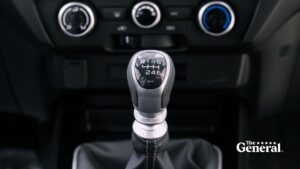A 1979 Mercedes-Benz 450 SEL Proves the Value of Slow, Unkillable Luxury

Photo: Courtesy Mercedes-Benz
The first thing I noticed was the smell, that indefinable nose of warm oil, unburned fuel, and the eternal off-gassing of plastic, wood, leather, and laminates selected and crafted by monomaniacal Mercedes engineers to last into the next geological time period. After that, of course, there’s the steering wheel. Approximately the circumference of a metal trashcan lid, the thin-rimmed tiller — which is not adjustable, and sits near my lap — has quite a bit of on-center play, intentionally built into the finger-light recirculating ball system to reduce driver fatigue on the Autobahn, which this car, the first true S-Class, was clearly designed to devour. I don’t so much steer the car as provide vague corrective inputs. This makes for some challenges while piloting a 1979 450 SEL sedan through some twisty bits of a fog-enveloped 40-mile stretch of one of the most iconic and gorgeous roads in America, the coastal California Highway 1 in and around Big Sur.
Photo: Courtesy Mercedes-Benz
The steering wheel fronted a series of standard-issue 1970s Benz VDO gauges and exactly zero active warning lights. This particular model is owned by the Mercedes-Benz Classic Center, a wholly-owned subsidiary of Mercedes Benz USA dedicated to the preservation, restoration, purchase, and sale of vintage cars with three-pointed stars. Most compelling among these gauges was the odometer, which, by the end of my journey, read at a stout 237,000 miles. The car did not have a squeak or a rattle anywhere. It ran perfectly.
Photo: Brett Berk
“We bought this car for a dollar,” says Mike Kunz, the genial director of the Classic Center. “The owner died and wanted to give it to a museum, and his mom wanted to honor his wishes, and they just persevered until we took it.”
G/O Media may get a commission
Up to 85% off
Jachs NY Summer Sale
Styles starting at $10
This sitewide sale will prepare you for any style situation that may arise in the transition between seasons—whether it be a henley and jeans or a button up and chino shorts moment.
The car had a number of period-correct modifications when it arrived in Kunz’s hands. “It had the gold kit that was quite popular at the time in some regions — on the star hood ornament, on the script on the back, on the grille badge, as well as on the locking centers of a set of Centra flat-surface chromed wheels,” Kunz said. When I told him I wish they’d left all of that on, he looked at me like I’d suggested a Brabus body-kit for a Gullwing.
The SEL also had an 800-watt stereo with giant subwoofers and door speakers when Kunz recieved it. “We took it out and put in a proper Becker Mexico,” Kunz said. I wished I’d brought some of my old mixtapes, but the antenna powered up and down properly, allowing me to seek out classical music on the local NPR affiliate. With the sunroof open — approximately the same scale as the steering wheel, meaning nearly the whole front third of the roof opens — and the sea air billowing in, I felt like one fancy bitch.
Photo: Brett Berk
As confident, competent and resolute as this S-Class was, it was not exactly fast. The 4.5-liter emissions-choked V8 produced just 190 hp. But it made a decent 240 lb-ft of torque, and this was its salvation. Like all S-Classes of the era, it prefers to get underway without ruffling anyone’s petticoats, in second gear, unless you command it into first by flooring the accelerator past kickdown. That thrummy V8 twist, however, gave it a sense of potency, especially once it was at speed. Blasts from 45 to 75 were delightful. Braking, from four-wheel discs (ABS was optional starting in 1979, the first production application in the industry) was steady and well-modulated, instilling a sense of security, as with literally everything else in the car.
In fact, Kunz and his team were so confident in this S-Class’s solidness that, immediately after I drove it, a pair of German journalists were slated to drive it across America. “I think it will be fine,” Kunz said, aware that his team had gone through the car and worked through any underlying issues.
Photo: Brett Berk
The W116’s somewhat baroque design limits its appeal in the current young-classic market, which is obsessed with 80s and 90s designs. (This car was among the last Benz models designed by Friedrich Geiger, whose career at the brand started, no lie, with the 500K of 1933.) I hadn’t really thought much about W116s, even though they were the classiest car of the first half of my childhood. But, like many things, with age — both the car’s and my own — they’ve started to look better. And because they didn’t make much power, and came from the Malaise Era, they are kind of the last remaining affordable S-Class.
Photo: Courtesy Mercedes-Benz
“Ten years ago, you could get these for $7,000 or $8,000 for a really nice one,” Kunz said. “Now it’s double or triple that.” But there are still many out there like this one, with high miles or not, that a bit of care can bring back. “These were among the most over-engineered cars ever built at Mercedes Benz,” Kunz said.
With a car like this, 237,000 miles is just getting broken in. I’m already searching Facebook Marketplace for one of my own.





